lights TOYOTA 4RUNNER 1999 Owner's Manual
[x] Cancel search | Manufacturer: TOYOTA, Model Year: 1999, Model line: 4RUNNER, Model: TOYOTA 4RUNNER 1999Pages: 268, PDF Size: 2.63 MB
Page 225 of 268

4RUNNER ()225
Tire surface and wheel nuts
Check the tires carefully for cuts, damage
or excessive wear. See Chapter 7- 2 for
additional information. When checking the
tires, make sure no nuts are missing, and
check the nuts for looseness. Tighten
them if necessary.
Tire rotation
Rotate the tires every 12000 km (7500
miles). See Chapter 7- 2 for additional in-
formation.
Fluid leaks
Check underneath for leaking fuel, oil, wa-
ter or other fluid after the vehicle has
been parked for a while. If you smell fuel
fumes or notice any leak, have the cause
found and corrected immediately.
Doors and engine hood
Check that all doors including back door
operate smoothly and all latches lock se-
curely. Make sure the engine hood sec-
ondary latch secures the hood from open-
ing when the primary latch is released.
INSIDE THE VEHICLE
Items listed below should be checked
regularly, e.g. while performing periodic
services, cleaning the vehicle, etc.
Lights
Make sure the headlights, stop lights, tail
lights, turn signal lights, and other lights
are all working. Check headlight aim.
Service reminder indicators and warning
buzzers
Check that all service reminder indicators
and warning buzzers function properly.
Steering wheel
Check that it has the specified freeplay.
Be alert for changes in steering condition,
such as hard steering or strange noise.
Seats
Check that all seat controls such as seat
adjusters, seatback recliner, etc. operate
smoothly and that all latches lock securely
in any position. Check that the head re-
straint move up and down smoothly and
that the locks hold securely in any latched
position. For folding- down rear seatbacks,
swing- up rear seat cushions and detach-
able temporary third seat, check that the
latches lock securely.Seat belts
Check that the seat belt system such as
buckles, retractors and anchors operate
properly and smoothly. Make sure the belt
webbing is not cut, frayed, worn or dam-aged.
Accelerator pedal
Check the pedal for smooth operation and
uneven pedal effort or catching.
Clutch pedal
Check the pedal for smooth operation.
Brake pedal
Check the pedal for smooth operation and
that the pedal has the proper clearance.
Check the brake booster function.
Brakes
At a safe place, check that the brakes do
not pull to one side when applied.
Parking brake
Check that the lever has the proper travel
and that, on a safe incline, your vehicle
is held securely with only the parking
brake applied.
Page 250 of 268

4RUNNER ()
250
If the headlights or other electrical
components do not work, check the
fuses. If any of the fuses are blown,
they must be replaced.
See ºFuse locationsº in Chapter 7- 1 for
locations of the fuses.
Turn the ignition switch and inoperative
component off. Pull a suspected fuse
straight out and check it.
Determine which fuse may be causing the
problem. The lid of the fuse box shows
the name of the circuit for each fuse. See
Part 8 of this manual for the functions
controlled by each circuit. Type A fuses can be pulled out by using
the pull- out tool. The location of the pull-
out tool is shown in the illustration.
If you are not sure whether the fuse has
blown, try replacing the suspected fuse
with one that you know is good.
If the fuse has blown, push a new fuse
into the clip.
Only install a fuse with the amperage rat-
ing designated on the fuse box lid.
If you do not have a spare fuse, in an
emergency you can pull out the ºPWR
OUTLETº or ºA.Cº fuse, which may be
dispensable for normal driving, and use it
if its amperage rating is the same.
If you cannot use one of the same amper-
age, use one that is lower, but as close
as possible to the rating. If the amperage
is lower than that specified, the fuse
might blow out again but this does not
indicate anything wrong. Be sure to get
the correct fuse as soon as possible and
return the substitute to its original clip.
It is a good idea to purchase a set of
spare fuses and keep them in your ve-
hicle for emergencies.
If the new fuse immediately blows out,
there is a problem with the electrical sys-
tem. Have your Toyota dealer correct it as
soon as possible.
CAUTION
Never use a fuse with a higher am-
perage rating, or any other object, in
place of a fuse. This may cause ex-
tensive damage and possibly a fire.
Page 251 of 268
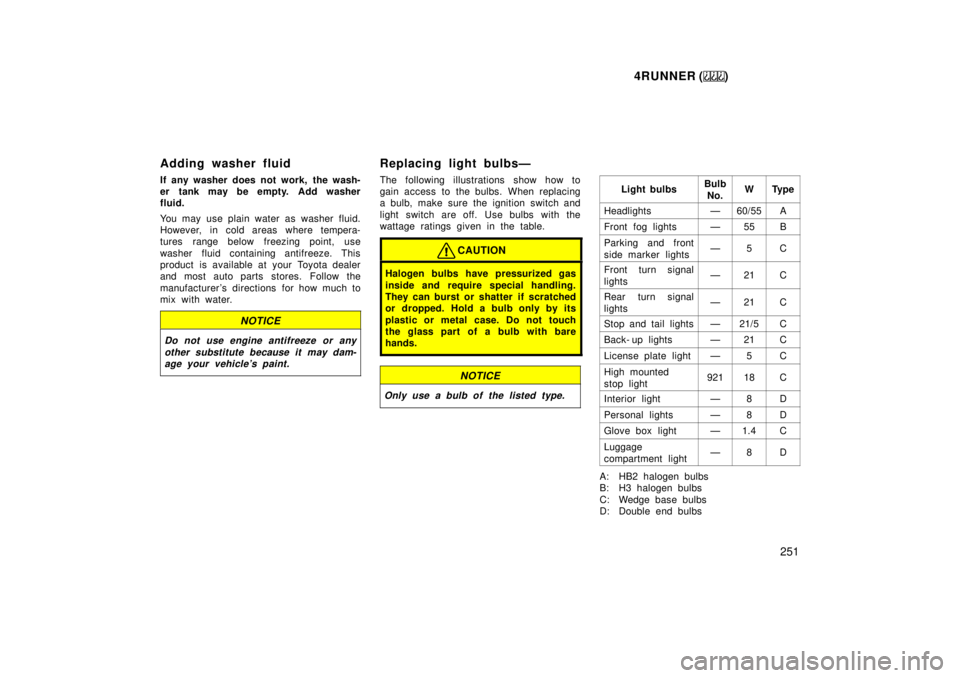
4RUNNER ()251
Adding washer fluid
If any washer does not work, the wash-
er tank may be empty. Add washer
fluid.
You may use plain water as washer fluid.
However, in cold areas where tempera-
tures range below freezing point, use
washer fluid containing antifreeze. This
product is available at your Toyota dealer
and most auto parts stores. Follow the
manufacturer 's directions for how much to
mix with water.
NOTICE
Do not use engine antifreeze or any
other substitute because it may dam-age your vehicle's paint.
Replacing light bulbsÐ
The following illustrations show how to
gain access to the bulbs. When replacing
a bulb, make sure the ignition switch and
light switch are off. Use bulbs with the
wattage ratings given in the table.
CAUTION
Halogen bulbs have pressurized gas
inside and require special handling.
They can burst or shatter if scratched
or dropped. Hold a bulb only by its
plastic or metal case. Do not touch
the glass part of a bulb with barehands.
NOTICE
Only use a bulb of the listed type.
Light bulbsBulb
No.WTy p e
HeadlightsÐ60/55A
Front fog lightsÐ55B
Par k i ng and fr ont
side marker lightsÐ5C
Front turn signal
lightsÐ21C
Rear turn signal
lightsÐ21C
Stop and tail lightsÐ21/5C
Back- up lightsÐ21C
License plate lightÐ5C
High mounted
stop light92118C
Interior lightÐ8D
Personal lightsÐ8D
Glove box lightÐ1.4C
Luggage
compartment lightÐ8D
A: HB2 halogen bulbs
B: H3 halogen bulbs
C: Wedge base bulbs
D: Double end bulbs
Page 252 of 268
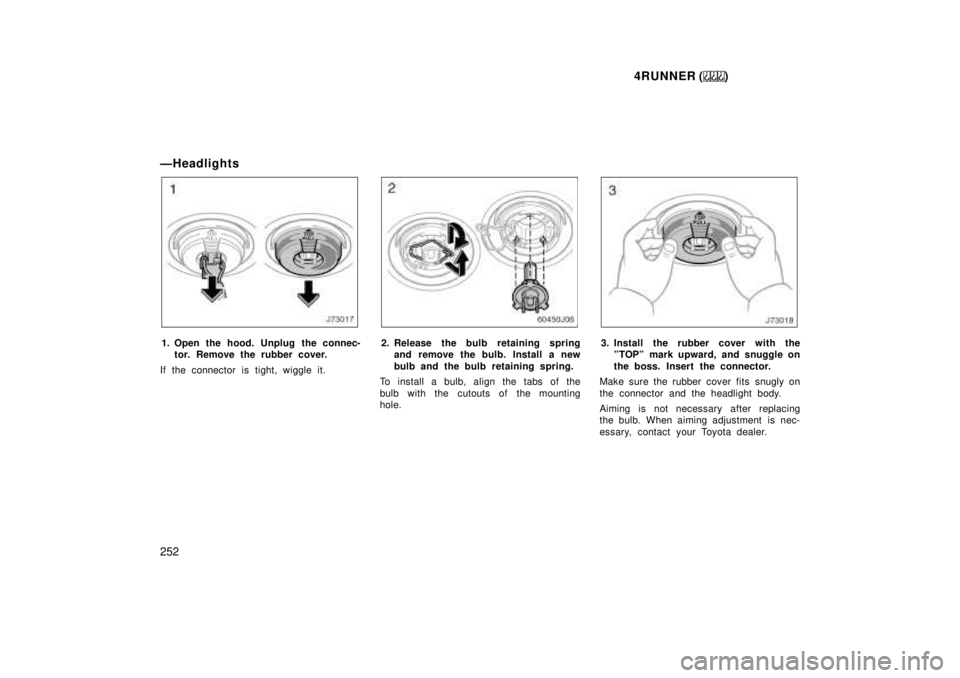
4RUNNER ()
252
ÐHeadlights
1. Open the hood. Unplug the connec-
tor. Remove the rubber cover.
If the connector is tight, wiggle it.2. Release the bulb retaining spring and remove the bulb. Install a new
bulb and the bulb retaining spring.
To install a bulb, align the tabs of the
bulb with the cutouts of the mounting
hole.3. Install the rubber cover with the ºTOPº mark upward, and snuggle on
the boss. Insert the connector.
Make sure the rubber cover fits snugly on
the connector and the headlight body.
Aiming is not necessary after replacing
the bulb. When aiming adjustment is nec-
essary, contact your Toyota dealer.
Page 253 of 268
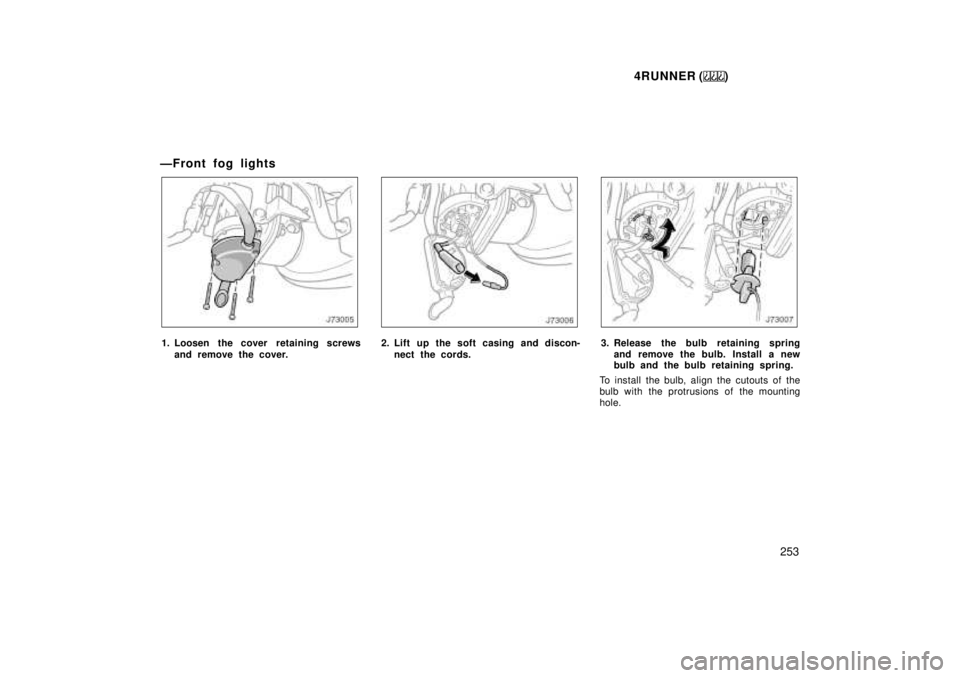
4RUNNER ()253
ÐFront fog lights
1. Loosen the cover retaining screws
and remove the cover.2. Lift up the soft casing and discon-nect the cords.3. Release the bulb retaining springand remove the bulb. Install a new
bulb and the bulb retaining spring.
To install the bulb, align the cutouts of the
bulb with the protrusions of the mounting
hole.
Page 254 of 268
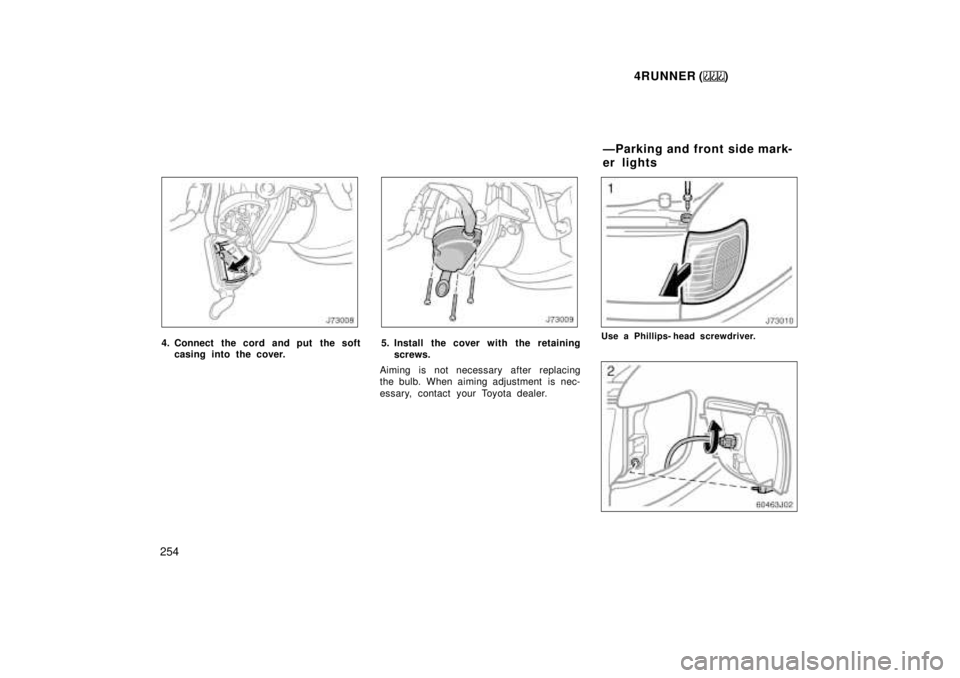
4RUNNER ()
254
4. Connect the cord and put the soft casing into the cover.5. Install the cover with the retaining
screws.
Aiming is not necessary after replacing
the bulb. When aiming adjustment is nec-
essary, contact your Toyota dealer.Use a Phillips- head screwdriver.
ÐParking and front side mark-
er lights
Page 255 of 268
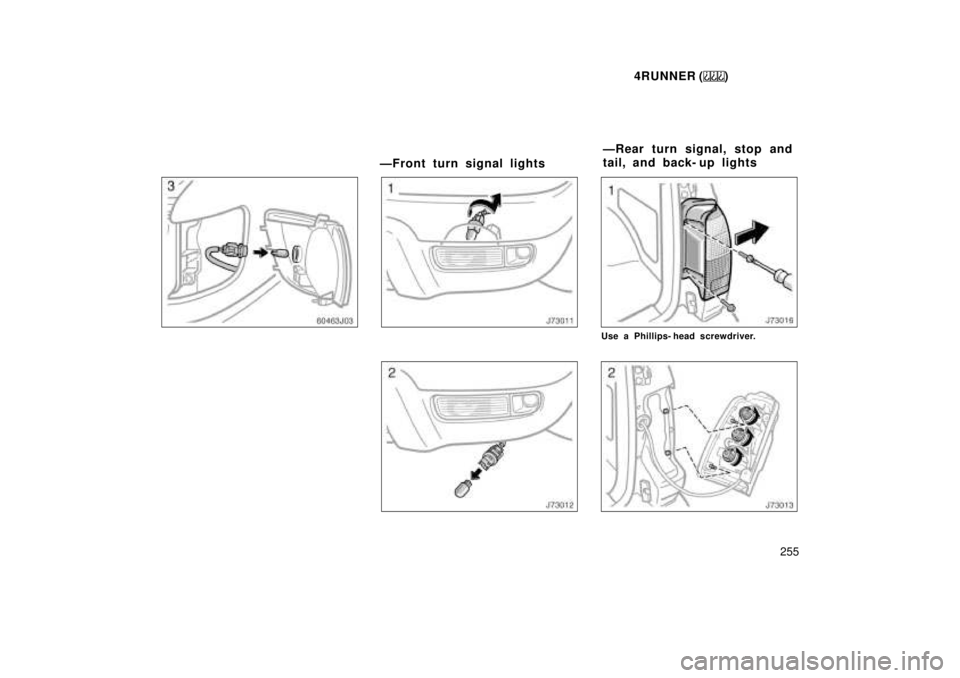
4RUNNER ()255
ÐFront turn signal lights
Use a Phillips- head screwdriver.
ÐRear turn signal, stop and
tail, and back- up lights
Page 256 of 268
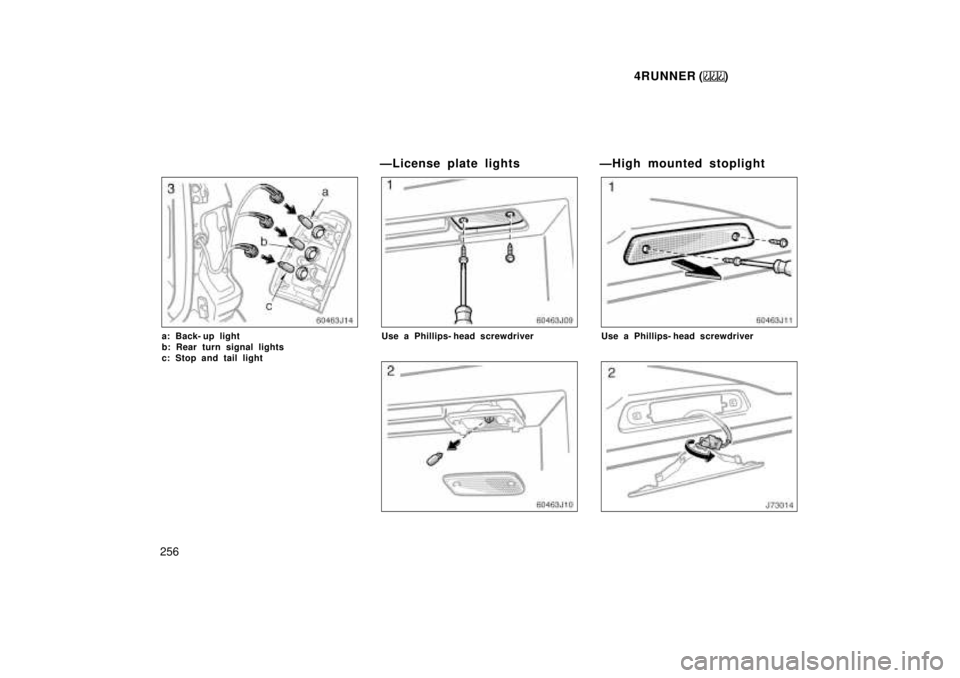
4RUNNER ()
256
a: Back- up light
b: Rear turn signal lights
c: Stop and tail light ÐLicense plate lightsUse a Phillips- head screwdriver
ÐHigh mounted stoplight
Use a Phillips- head screwdriver
Page 261 of 268
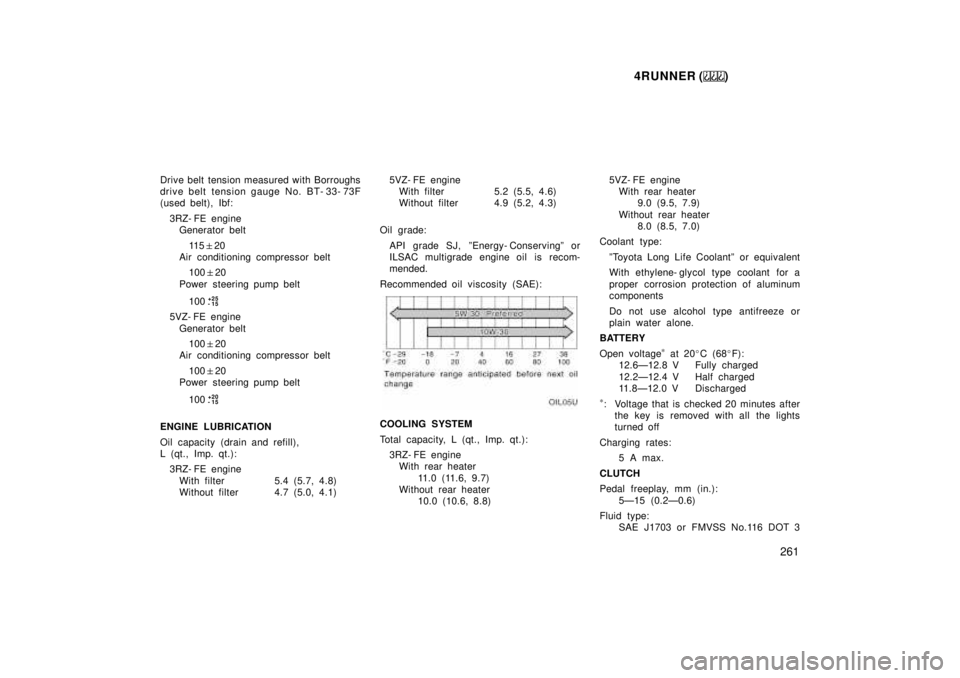
4RUNNER ()261
Drive belt tension measured with Borroughs
drive belt tension gauge No. BT- 33- 73F
(used belt), Ibf:
3RZ- FE engineGenerator belt
11 5 �20
Air conditioning compressor belt
100 �20
Power steering pump belt
100 +25
-15
5VZ- FE engine Generator belt
100 �20
Air conditioning compressor belt
100 �20
Power steering pump belt
100 +20
-15
ENGINE LUBRICATION
Oil capacity (drain and ref ill),
L (qt., Imp. qt.):
3RZ- FE engineWith filter 5.4 (5.7, 4.8)
Without filter 4.7 (5.0, 4.1) 5VZ- FE engine
With filter 5.2 (5.5, 4.6)
Without filter 4.9 (5.2, 4.3)
Oil grade: API grade SJ, ºEnergy- Conservingº or
ILSAC multigrade engine oil is recom-
mended.
Recommended oil viscosity (SAE):
COOLING SYSTEM
Total capacity, L (qt., Imp. qt.): 3RZ- FE engine With rear heater
11.0 (11.6, 9.7)
Without rear heater 10.0 (10.6, 8.8) 5VZ- FE engine
With rear heater 9.0 (9.5, 7.9)
Without rear heater 8.0 (8.5, 7.0)
Coolant type:
ºToyota Long Life Coolantº or equivalent
With ethylene- glycol type coolant for a
proper corrosion protection of aluminum
components
Do not use alcohol type antifreeze or
plain water alone.
BATTERY
Open voltage *
at 20 �C (68 �F):
12.6Ð12.8 V Fully charged
12.2Ð12.4 V Half charged
11.8Ð12.0 V Discharged
* : Voltage that is checked 20 minutes after
the key is removed with all the lights
turned off
Charging rates: 5 A max.
CLUTCH
Pedal freeplay, mm (in.): 5Ð15 (0.2Ð0.6)
Fluid type: SAE J1703 or FMVSS No.116 DOT 3
Page 264 of 268
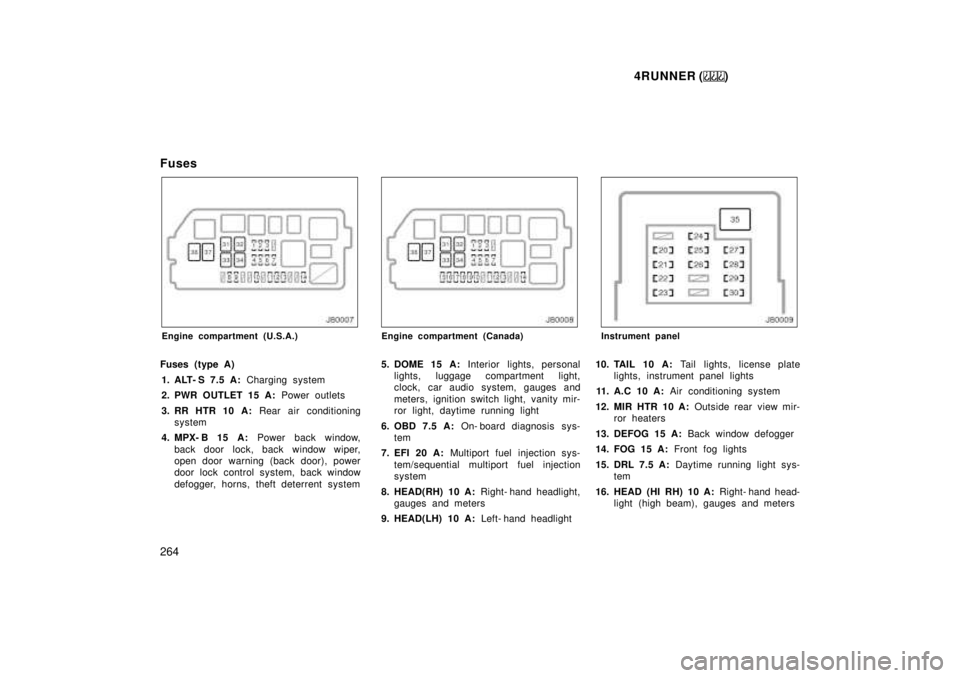
4RUNNER ()
264
Fuses
Engine compartment (U.S.A.)
Fuses (type A) 1. ALT- S 7.5 A: Charging system
2. PWR OUTLET 15 A: Power outlets
3. RR HTR 10 A: Rear air conditioning
system
4. MPX- B 15 A: Power back window,
back door lock, back window wiper,
open door warning (back door), power
door lock control system, back window
defogger, horns, theft deterrent systemEngine compartment (Canada)
5. DOME 15 A: Interior lights, personal
lights, luggage compartment light,
clock, car audio system, gauges and
meters, ignition switch light, vanity mir-
ror light, daytime running light
6. OBD 7.5 A: On- board diagnosis sys-
tem
7. EFI 20 A: Multiport fuel injection sys-
tem/sequential multiport fuel injection
system
8. HEAD(RH) 10 A: Right- hand headlight,
gauges and meters
9. HEAD(LH) 10 A: Left- hand headlightInstrument panel
10. TAIL 10 A: Tail lights, license plate
lights, instrument panel lights
11. A.C 10 A: Air conditioning system
12. MIR HTR 10 A: Outside rear view mir-
ror heaters
13. DEFOG 15 A: Back window defogger
14. FOG 15 A: Front fog lights
15. DRL 7.5 A: Daytime running light sys-
tem
16. HEAD (HI RH) 10 A: Right- hand head-
light (high beam), gauges and meters